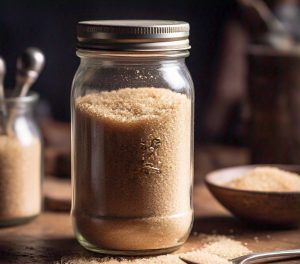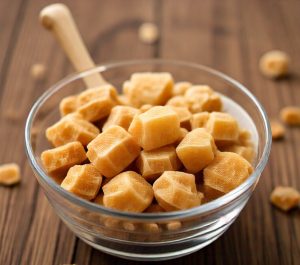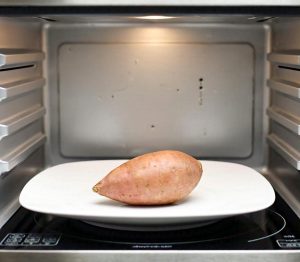Brown sugar is a type of sweetener produced from either cane or beet sugar along with the addition of molasses, which gives it its distinctive color and flavor.
The question at hand is whether brown sugar can be softened in the microwave when it turns hard.
This article will delve into details surrounding brown sugar, focusing on its microwavable properties. We will explore if and how you can soften hardened brown sugar in the microwave, including specifics about the necessary duration for adequate softening. Potential impacts on nutritional value and taste resulting from this heating process will also be discussed. In case microwaving isn’t advisable, we’ll provide alternative methods to achieve similar results while preserving both nutrients and flavors. Further included are helpful tips and precautions to ensure safety during any procedure mentioned, as well as answers to frequently asked questions pertaining to this topic for comprehensive understanding.

Jump To:
Is it Possible to Soften Brown Sugar in the Microwave?
Yes, you can soften brown sugar in the microwave. This method is quicker than other traditional methods of softening brown sugar. Care must be taken not to overheat the sugar as it might melt or burn. Protecting your microwave and using a low-power setting are crucial elements when executing this task.
Check out if you can microwave crystallized honey.
Facts About Softening Brown Sugar in the Microwave
Here we will discuss the important things to note about softening brown sugar in the microwave.
- Nature of brown sugar: Brown sugar has a naturally moist texture due to molasses. Microwaving it can help restore this moisture if it dries out and hardens.
- Microwave-safe bowl: It is necessary to use a microwave-safe bowl while microwaving brown sugar. This ensures safety and avoids any unwanted incidents.
- Addition of water: A few drops of water can be added to enhance the softening process, as they create steam when heated which helps soften the hardened sugar.
- Covering with a paper towel: A damp paper towel should be placed over the bowl before microwaving, this aids in creating an environment for steaming which facilitates softening.
- Microwave time duration: The ideal time for microwaving varies but usually between 20-30 seconds at medium power level works best. Overheating may melt and burn your sugar. Always start with shorter intervals and add more as needed
We have now discussed essential facts related to softening brown sugar using a microwave.
Now we will delve into some additional considerations on how best to microwave brown sugar.
How Long Can You Microwave Brown Sugar to Soften it?
You can typically soften hardened brown sugar in the microwave within 20 to 30 seconds. The time may vary depending on the power of your microwave and how hard the sugar is. It’s best to start with a short period, such as 10-15 seconds, then gradually increase if necessary until achieving the desired softness. Remember that prolonged heating might cause the sugars to caramelize or even burn.
Check out if you can soften butter in the microwave.
Does Heating Brown Sugar in a Microwave Destroy its Nutrients? Does it Damage it? How Does Heating Food with Brown Sugar Affect the Food?
Microwaving doesn’t significantly degrade or destroy nutrients present in brown sugar because they are relatively heat-stable. However, excessive heat could potentially change its structure causing caramelization, which might lead to a slightly different flavor profile when used in dishes. As for food preparation, microwaving foods with added brown sugar usually enhances their sweet taste while contributing additional moisture due to their molasses content.
Does Heating Brown Sugar in a Microwave Affect its Flavors?
Heating up brown sugar should preserve most of its original flavor profile since essential aspects like molasses remain basically unaffected during microwaving process. However one should note that excessive or prolonged exposure might cause slight caramelization leading possibly towards an enhanced depth of flavor – attributed mainly to changed physical properties rather than chemical alterations.
We have now discussed various facets related to microwaving softened brown sugar, including the optimal duration for warming, potential effects on nutritional value and flavor characteristics post-heating procedure.
In our next section, we’ll be addressing some frequently asked questions touching upon these topics further.

Frequently Asked Questions (FAQs)
We will now look at the most commonly asked questions related to softening brown sugar in the microwave.
Can you soften brown sugar in the microwave?
Yes, you can soften brown sugar in the microwave. To do this, place your hard, lumpy brown sugar in a microwave-safe bowl and cover it with a damp paper towel. Heat it on high for 20-30 seconds at a time until it’s soft. Remember to be cautious as overheating may cause the sugar to melt.
Does heating affect the quality of brown sugar?
No, heating does not generally affect the quality of brown sugar if done properly. However, overheating might result in melting or burning which could alter its taste and texture significantly. So always heat in short intervals and check frequently.
Can all types of microwaves be used for softening brown sugar?
Surely yes! Most types of microwaves are suitable for softening brown sugar irrespective of their power level or brand. Just make sure you use a microwave-safe container and adjust heat settings based on the wattage capacity of your appliance.
Is it safe and healthy to warm up brown sugar in a microwave?
Certainly yes! Warming up or softening brown sugar using a microwave doesn’t produce any harmful substances nor degrades nutritional value making it a safe and healthy method provided correct guidelines are followed during the process.
Check out if you can microwave nutella.
This concludes our frequently asked questions section about softening brown sugar using a microwave.
Final Word
Microwaving is an effective technique used worldwide to soften hardened blockages of delicious sweetener like brown sugars, helping home cooks and professional chefs alike. It’s a quick, easy, safe and convenient method that helps maintain the sugar’s quality intact while making it ready to use in any recipe of your choice.



